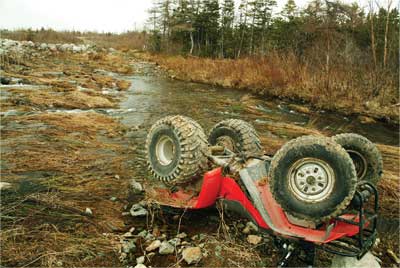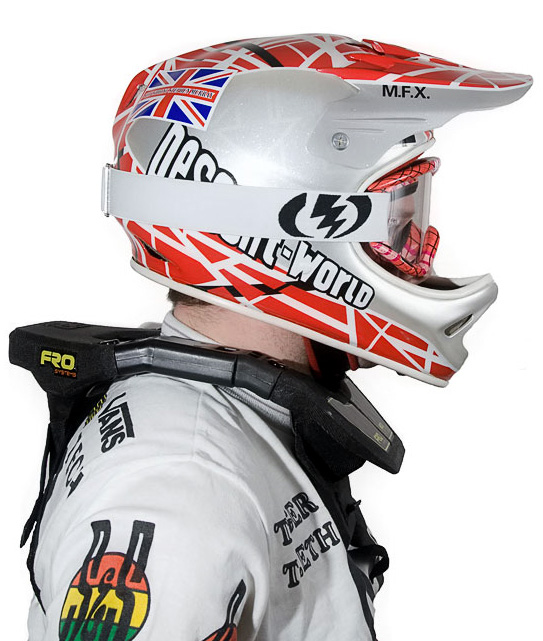ATV Riding Techniques
 You don’t have to be an atv racer or even a recreational rider to benefit from some of the many techniques and innovations throughout the years that have been perfected to enhance the riding experience. The following is a collection of riding tips and crash-survival methods that have proven successful time and time again. While each crash situation is unique and no amount of prepping can encompass every possible outcome, the general ideas here can certainly lessen the risk of catastrophe. Without further ado:
You don’t have to be an atv racer or even a recreational rider to benefit from some of the many techniques and innovations throughout the years that have been perfected to enhance the riding experience. The following is a collection of riding tips and crash-survival methods that have proven successful time and time again. While each crash situation is unique and no amount of prepping can encompass every possible outcome, the general ideas here can certainly lessen the risk of catastrophe. Without further ado:
The Chicken Dance
 Have you ever tried to do a push up with your elbows close together? You may notice it’s a lot tougher than doing it with your elbows out and this same principle applies to ATV riding as well. When holding the bars, try to make a conscious effort to keep your elbows up. Not only does this position offer more steering leverage (which is the name of the game in ATV steering), it has a subconscious effect on the lungs opposed to riding with your elbows tucked closely to your chest. With your arms farther away from your chest, your lungs will have an easier time filling with air.
Have you ever tried to do a push up with your elbows close together? You may notice it’s a lot tougher than doing it with your elbows out and this same principle applies to ATV riding as well. When holding the bars, try to make a conscious effort to keep your elbows up. Not only does this position offer more steering leverage (which is the name of the game in ATV steering), it has a subconscious effect on the lungs opposed to riding with your elbows tucked closely to your chest. With your arms farther away from your chest, your lungs will have an easier time filling with air.
This Isn’t Swimming
Additionally most riders display the disturbing trend of holding their breath in instances where the going gets rough. This is perhaps the most counterproductive thing to do in nearly any situation. Since your mind will likely be quite occupied with whatever it is before you that’s causing you to panic, practice getting into the habit of exhaling strongly. Forcing the air from your lungs will automatically cause you to take a deep inhalation. The benefit of muscles filled with blood-rich oxygen is that they’ll certainly have an easier time negotiating the terrain. Smooth, steady breathing is an oft-overlooked secret to tapping into the body’s natural abilities. This applies to epic trail rides just as it does to racing.
Crash and Burn
We’ve all heard the “logic” that the best way to avoid a crash-related injury is to avoid the crash but there are instances where situations simply set us up for the inevitable. In the very early stages of a crash, there are proven steps to perform to, at the very least, minimize the potential damage to the body caused by impact (be it with the ground, ATV, or another rider). In a ground-based crash it is always best to attempt to land on your feet first then tuck and roll with the momentum rather than to try to fight it. If hitting the deck ground-first isn’t an option, the next important thing to do is to make your body as loose and limber as possible. Instinct will launch your hands forward to brace for impact but a vast majority of injuries come from stiff arms and locked elbows. With a loose mindset, your arms will collapse upon impact (rather than accept the brunt of the force). From here, it should be possible to tuck and roll onto your back. Again the idea here is to avoid doing more harm to your internals by fighting the momentum. If you were traveling at 50 miles per hour before being ejected, your body will still be traveling at that speed even if the quad has been stopped in its tracks. Rolling to defuse this momentum is critical.
While it isn’t always avoidable, another tip to keep in mind is the importance of not becoming entangled with the machine. Remember, in most cases the quad far outweighs the rider. If whenever possible, plan your emergency exit away from the momentum of the vehicle. This is especially pertinent to bailouts that occur during flight. Sometimes it works best to leap over the front of the crashing machine, others the rear. If you find yourself in a hard sideways skid and fear that the machine will high side then tumble, always bail in the opposite direction of the skid- this will place you safely behind the toppling ATV.
When It’s Better To Ride It Out
Remember there are situations where it’s better not to bail out. When coming up short on a jump, it’s wiser to loosen up and ride out the impact rather than to try and jump off. Let the suspension absorb as much of the impact as possible as it will surely outperform your legs alone. Same holds true for over-jumping a landing.
Should you find yourself in this situation, relax your body while slightly bending your knees and elbows. Let the natural give of your joints absorb what impact your shocks have failed to.
Gear Up
 Finally, the most important tip of all when it comes to increasing the probability of surviving the inevitable digger is to always wear the appropriate safety gear. Riding boots are monumental in reducing ankle flex, helmets not only absorb impact force that would otherwise be transferred directly to the head but they also protect against abrasions and lacerations. Goggles, gloves, neck rolls (or better yet a full neck brace), kidney belts, chest protectors and knee braces all exist to supplement the body’s natural ability to survive a crash. Get into the habit of wearing as much gear as possible each and every time you ride. Eventually you’ll have become so accustomed to your gear that you’ll feel totally naked without it.
Finally, the most important tip of all when it comes to increasing the probability of surviving the inevitable digger is to always wear the appropriate safety gear. Riding boots are monumental in reducing ankle flex, helmets not only absorb impact force that would otherwise be transferred directly to the head but they also protect against abrasions and lacerations. Goggles, gloves, neck rolls (or better yet a full neck brace), kidney belts, chest protectors and knee braces all exist to supplement the body’s natural ability to survive a crash. Get into the habit of wearing as much gear as possible each and every time you ride. Eventually you’ll have become so accustomed to your gear that you’ll feel totally naked without it.
Toss your cell phone under your seat in a sealed zipper lunch bag (to keep it dry) and a word to the wise: Make sure it’s fully charged before you head out. Not only will this allow you to call for help should you need it, but a cell phone’s signal can help authorities track you down even if you can’t operate the phone itself.
To discuss this article, click here.
